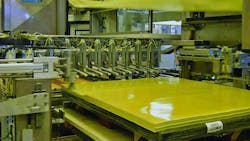PCB Materials Pave the Way to Faster, Higher-Frequency Circuits
This article is part of our IMS2022 coverage.
Designers looking to trim losses, size, and weight from high-speed, high-frequency printed-circuit boards (PCBs) will want to visit Isola Group in Booth #5090 at IMS2022. There, the company will display an array of its advanced circuit materials, which are formulated for low loss in RF/microwave and mmWave circuits to 110 GHz and beyond, as well as high levels of signal integrity in high-speed-digital (HSD) circuits well into the Gb/s speed range.
Isola’s circuit materials support the current industry trends in higher-frequency operation and miniaturization, but they do so while paying close attention to manufacturing requirements, with materials that can be transformed into PCBs using the same processes used for many popular circuit materials, such as mid-and-high-Tg FR-4 materials.
For example, Astra MT77 features low loss through mmWave frequencies, with characteristics such as dielectric constant (Dk) and dimensions that are stable over wide temperature ranges, making this an ideal circuit material for automotive and military radar applications. It exhibits a Dk of 3.00 at 10 GHz with a dissipation factor (Df) of 0.0017 at 10 GHz denoting extremely low loss. For digital circuits, Tachyon 100G laminates and prepregs support speeds to 100 Gb/s and higher. They have characteristics closely matched to Astra MT77, with Dk of 3.02 at 10 GHz and Df of 0.0021 at 10 GHz. The coefficient of thermal expansion (CTE)—how the materials’ dimensions change with temperature—is also similar across operating temperatures from -55 to +125°C, making these materials well matched for hybrid material blends in PCB assemblies for HSD and microwave/mmWave circuits.
Another circuit material well matched to Astra MT77 in CTE, I-Tera MT40 (RF/MW), has a slightly higher Dk, 3.45 at 10 GHz, but also with very low loss, signified by a Df of 0.0031 at 10 GHz. Both have the qualities needed for many emerging mmWave circuit applications, such as in automotive radar collision-avoidance systems and in 5G wireless communications networks. And both materials are FR-4 process compatible for ease of circuit fabrication.
For more information, visit the company website.
For more IMS2022 coverage, visit our digital magazine.
About the Author
David Maliniak
Executive Editor, Microwaves & RF
I am Executive Editor of Microwaves & RF, an all-digital publication that broadly covers all aspects of wireless communications. More particularly, we're keeping a close eye on technologies in the consumer-oriented 5G, 6G, IoT, M2M, and V2X markets, in which much of the wireless market's growth will occur in this decade and beyond. I work with a great team of editors to provide engineers, developers, and technical managers with interesting and useful articles and videos on a regular basis. Check out our free newsletters to see the latest content.
You can send press releases for new products for possible coverage on the website. I am also interested in receiving contributed articles for publishing on our website. Use our contributor's packet, in which you'll find an article template and lots more useful information on how to properly prepare content for us, and send to me along with a signed release form.
About me:
In his long career in the B2B electronics-industry media, David Maliniak has held editorial roles as both generalist and specialist. As Components Editor and, later, as Editor in Chief of EE Product News, David gained breadth of experience in covering the industry at large. In serving as EDA/Test and Measurement Technology Editor at Electronic Design, he developed deep insight into those complex areas of technology. Most recently, David worked in technical marketing communications at Teledyne LeCroy, leaving to rejoin the EOEM B2B publishing world in January 2020. David earned a B.A. in journalism at New York University.

